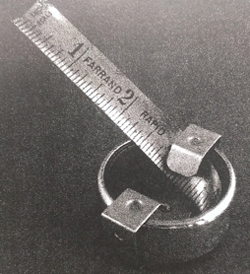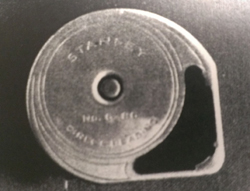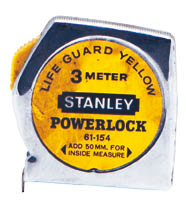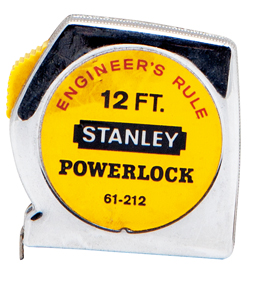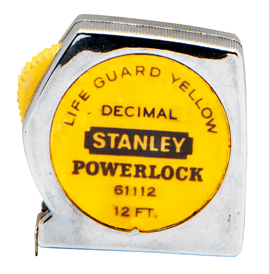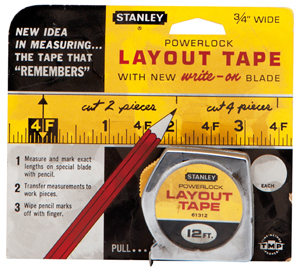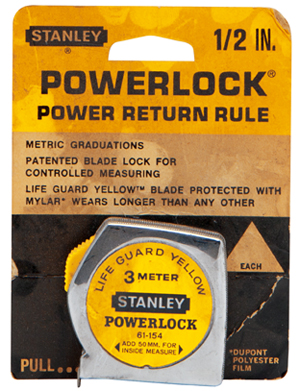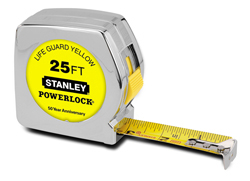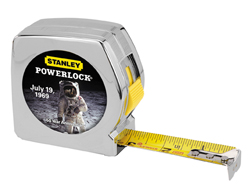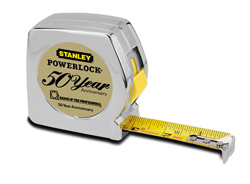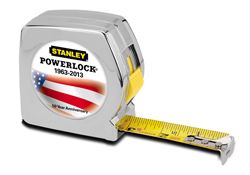
It’s hard to imagine measuring, especially anything more than a yardstick long, without a retractable tape measure. Tape measures are as common to the measuring and marking process as a sharp pencil, and for that universality and convenience, we have Stanley’s® PowerLock® to thank. The company is celebrating the tape measure’s half-century birthday this year.
“It surprises many people I talk to when they learn that Stanley didn’t actually invent the tape measure,” says Tom Chang, Stanley’s global product manager for measuring and layout tools. “The first coiling tape measure was Hirand Farrand’s invention, back in 1922. And it didn’t look much like the tape measures we know today.”
Farrand’s original tape measure was 6 ft. long. It didn’t have a locking mechanism or a spring to pull the tape back into its case. Instead, Chang explains, the steel tape was manually coiled inside of an open-ended can, and initially it was called a “Farrand Rule” or a “push-pull” tape. But the convenience of being able to house a 6-ft. measuring instrument in a container small enough to fit in a pocket, and the potential of that tape to become much longer than 6 ft., captured Stanley’s attention. The company purchased the rights to produce Farrand’s push-pull tape from him in 1931, and Farrand came to work for Stanley the same year.
It only took a year for Stanley to expand on Farrand’s concept and roll out three tiers of new tape measures, targeted at different end users. Stanley’s “Defiance” push-pull tape was economically priced and intended for homeowners and farmers. Its “Four Square” tape was a step up from the Defiance and featured a blade that could be removed from the case and used flat for taking inside measurements. Top of the line was the “Stanley” series of various tapes, which came in several different case styles and were marketed to craftsman and other trade professionals. Unlike Farrand’s original design, all three tiers of tapes were encased in closed housings rather than open-ended canisters.
About six years later, Stanley created the first model with a locking but not self-retracting blade.
During WWII, Chang says, the war slowed down both the production and sale of Stanley tape measures. But that lag proved to be fleeting. As soon as the war ended, Stanley reintroduced many of its previous models and rolled out the first tape measure with a replaceable blade. Then, during the housing boom that followed, the company introduced a D-shaped case with a flat bottom edge and a right angle design. It’s the same case shape that is used today on PowerLock tapes, and it enabled a tape measure to take “inside” measurements using the case itself as part of the measurement. Stanley also added its Tru-Zero Hook to the end of the tape. It’s now the ubiquitous tip style of every tape measure on the market. In 1956, the company added a retracting spring, which marked the tool’s evolution as the first “modern” coilable and retractable tape measure.
“Then in 1963, Stanley applied and received the PowerLock patent. It focused on our slide lock innovation that allowed an end user to extend and then lock the tape in place. That was really important, because for the first time a tape measure could be used one-handed, rather than having to hold the tape’s case in one hand and the extended tape with the other hand.”
That one-handed convenience would no doubt benefit the limited mobility of an astronaut confined inside of a space suit. So, a PowerLock tape was included in the landing gear of NASA’s Apollo 11 space mission in 1969.
Eventually, patents expire, and so did Stanley’s PowerLock patent in the late 1970s. “When that happened, and from then on, our PowerLock became the most copied tape measure design in the world,” Chang says.
But despite increasing competition, and certainly influenced by it, too, Stanley continued to innovate tape measure designs. It teamed up with DuPont™ to add Mylar® polyester film to PowerLock blades in the early 60s, and Mylar continues to be used by Stanley even today. The coating adds rust-proofing durability and extends the life of the blade. Stanley also experimented with blade color options, including white. Its “Life Guard Yellow” proved to be most popular and expanded the range of tape lengths. What started at 6 ft. became 8-, 10-, 12- and 16-ft. options, then 25-, 30- and 35-ft. models. Chang says that today, the 25-ft. option continues to be the most popular length for tradespeople, woodworkers and DIYers.
“These days, we manufacture 31 versions of the PowerLock in seven different sizes and offer them in 66 countries. But, we are also proud to say that because of many cost-saving improvements and automation, we are still manufacturing PowerLock tapes in the United States in our original New Britain, Connecticut, tape rule plant. More than nine million PowerLock tapes are manufactured there each year.”
To mark 50 years of this iconic measuring tool, Stanley will offer four different commemorative versions of the 25-ft. tape in 2013, with side decals marking Life Guard Yellow, American Flag, the Apollo 11 Mission and “Badge of the Professional.” Life Guard Yellow is available now through various retailers, and the three other designs will be released in June.
To learn more about Stanley’s PowerLock tape measures and other measuring tools, click here.
